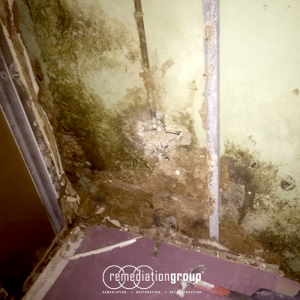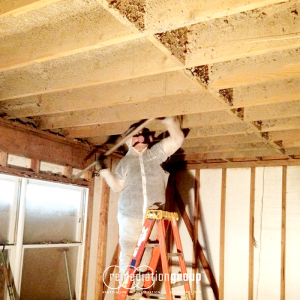&*&*&
Interior Spaces
Invasive Mold Removal vs. Non Invasive Mold Removal
Maintaining your home and protecting your family from avoidable disease are two good reasons to assess the potential impact of mold on your home. Many families wait until mold contamination is very high before acting to correct this problem. In most cases, an ounce of prevention can avoid untold expense left in the wake of unattended mold infestation.
If mold is found in your home, there are two potential paths of remediation. The degree of contamination will determine which path is recommended. The remediation process can be either invasive or non-invasive. Non-invasive remediation is generally less involved, requiring minimal reconstruction and repairs following the process. Therefore, it is less expensive.
Picture of House with Mold remgroupinc_com-reseidentialmoldafter.jp
Non-Invasive Remediation
This remediation process consists mostly of HEPA vacuuming, sanding, surface wiping and HEPA air filtering. Most building materials contaminated with surface mold (wood, glossy painted wood, glass, metal, ceramic, etc.) can be effectively decontaminated with this non-invasive process and pass third party environmental assessment and testing. The main cause of surface mold is the increase in relative humidity (Rh) inside the structure. In these cases, non-invasive remediation is generally the best option for your home.
Invasive Remediation
This remediation process consists of removing and discarding porous building materials that cannot be decontaminated through non-invasive means. Moisture infiltration typically causes moisture to penetrate walls and generate mold inside wall cavities. Generally, this is caused by moisture entering your home’s exterior envelope through compromised roofing or siding or through an interior water source, such as piping or faucets. Seepage, flooding and leaks create a tremendous mess for the homeowner. These problems result in severe material damage that many times requires some level of invasive remediation. From a cost perspective, the labor of invasive remediation is slightly more expensive, but what truly drives up the cost of this remediation is the reconstruction and repair necessary following the removal of mold damaged building materials.
Forensic Discovery of Mold Invasive Mold
For more information on mold and your home, read the following article by the Environmental Protection Agency (EPA): Residential Mold Guide.
IICRC S500 Certified Mold Remediation Standard
IICRC Certification The Institute of Inspection, Cleaning and Restoration Certification (IICRC) has served as the Industry Guardian for the cleaning, inspection and restoration service industries for more than 30 years. As a non-profit certification organization, the IICRC helps ensure that you have access to trusted and trained cleaning professionals by establishing and monitoring certification programs and standards for these industries.
More Information
For more information on mold contamination and its threat to your business, home and health, click to read two EPA (Environmental Protection Agency) reports: Residential Mold Guide and Mold Remediation in Schools and Commercial Buildings -2001 document.&*&*&

























